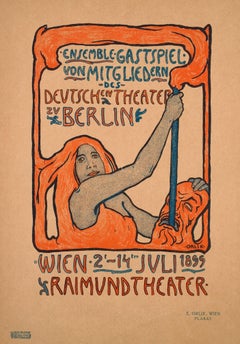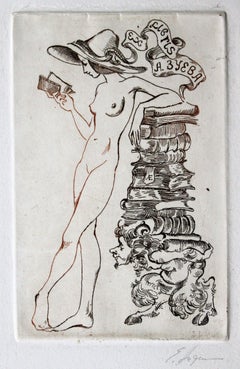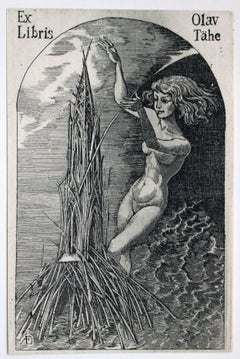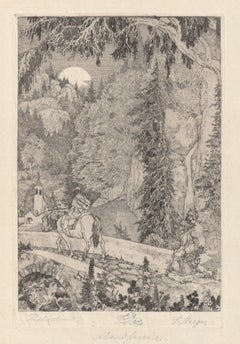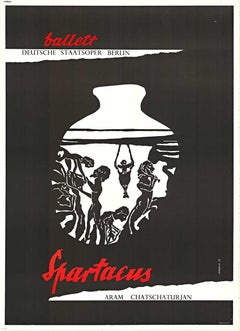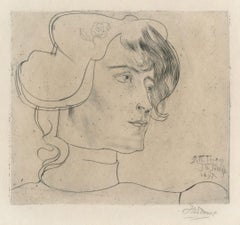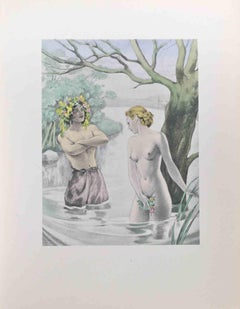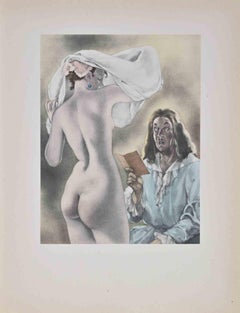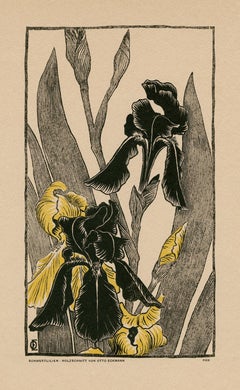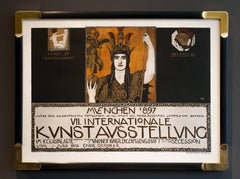Jugendstil Figurative Prints
to
4
7
1
2
Overall Width
to
Overall Height
to
15,498
7,990
2,627
2,427
2,255
1,002
994
728
663
412
323
112
93
39
1
1
1
3
7
1
1
1
3
6
4
7
3
3
3
3
3
2
2
2
2
2
1
1
1
1
6
3
3
1
1
5
5
Style: Jugendstil
Performance by members of the Deutsches Theater zu Berlin / - Ornamental Flow -
By Emil Orlik
Located in Berlin, DE
Emil Orlik (1870 Prague - 1932 Berlin), Ensemble guest performance by members of the Deutsches Theater zu Berlin, 1899. Color lithograph on wove paper, 20 cm x 13.3 cm (image), 29.5 ...
Category
1890s Jugendstil Figurative Prints
Materials
Paper
Ex Libris. Paper, etching, 11x7 cm
Located in Riga, LV
Ex Libris A. Zuyeva
Paper, etching, 11x7 cm
Category
1990s Jugendstil Figurative Prints
Materials
Paper, Etching
$170 Sale Price
20% Off
Ex libris. Paper, woodcut, 11x7cm
Located in Riga, LV
Ex libris Olav Tähe
Paper, woodcut, 11x7cm
Category
1990s Jugendstil Figurative Prints
Materials
Paper, Woodcut
$170 Sale Price
20% Off
Troubadour, from The Mastersingers of Nuremberg
Located in Middletown, NY
Stipple point etching on tissue-thin handmade Japon paper, 7 5/8 x 5 inches (193 x 126 mm), full margins. Signed, titled, dated, inscribed and numbered 10/25 in pencil, lower margin....
Category
Early 20th Century Jugendstil Figurative Prints
Materials
Handmade Paper, Etching
Original Spartacus Deutsche Staatsoper Berlin vintage theater poster
Located in Spokane, WA
Original poster: Spartacus, Beutsche Staatsoper Berlin (Germany) vintage theater poster.
Printed in 1973 to promote a performance of Spartacus ...
Category
1970s Jugendstil Figurative Prints
Materials
Lithograph
Woman's Head (Vrouwekop), Marguerite Adolphine Helfrich
By Jan Toorop
Located in Fairlawn, OH
Woman's Head (Vrouwekop), Marguerite Adolphine Helfrich
Drypoint, 1897
Signed lower right in pencil: J Toorop; by later hand
Toorop's model for this print was Marguerite Adolphine H...
Category
1890s Jugendstil Figurative Prints
Materials
Drypoint
Death and Life / - United in Laughter -
By Hans Frank
Located in Berlin, DE
Hans Frank (1884 Vienna - 1948 Salzburg), Death and Life, 1911. Lithograph, 18 cm x 31 cm (depiction), 25.5 cm x 38.7 cm (sheet size), signed “H.[ans] Frank” in pencil lower right and inscribed “Tod und Leben” lower left.
- darkened, remains of an old mounting on the verso
- United in Laughter -
Here, Hans Frank refers to the skull as a vanitas motif. In Renaissance and Baroque portraits, this motif symbolizes the transience of the sitter, whose head has become a skull over time. Penitents, such as St. Jerome, often hold skulls in melancholy contemplation. Here, however, the boy stands up for life itself. He boldly grabs the skull and laughs at the absurdity of life and death. The laughter of death joins the laughter of life, and vice versa. The child's thumb penetrates the skull's cheekbone to illustrate the inseparable connection between death and life.
About the artist
Hans Frank studied at the Vienna School of Applied Arts from 1902 to 1906 and then studied painting under Franz Rumpler at the Vienna Academy of Fine Arts from 1907 to 1911. In 1911, he received a substantial travel grant from the emperor, which he used to travel to Switzerland, Paris, London, Belgium, the Netherlands, and Germany. After serving in World War I, Frank moved to St. Marein im Mürztal, returning to Vienna in 1925. He took further study trips to Italy, southern France, and the Austrian countryside. In 1927, Frank became a member of the London Society of Color Printers. An exhibition of his work at the Medici Gallery in London brought him international recognition. He joined the Pasadena Printmakers Society of California and established contacts in Canada. In addition to his highly regarded paintings, Frank primarily worked as a graphic artist. He created over 300 prints and developed a new gradient technique for the fern woodcut with his twin brother, Leo Frank...
Category
1910s Jugendstil Figurative Prints
Materials
Paper
School Girls of Vienna Packing Rations from England and America for the Children
Located in Fairlawn, OH
School Girls of Vienna Packing Rations from England and America for the Little Children
Color lithograph poster, 1921
Signed lower right in the text (see photo)
Created in the Wein (...
Category
1920s Jugendstil Figurative Prints
Materials
Lithograph
Three graces. Paper, etching, 12x11cm
Located in Riga, LV
Three graces. Paper, etching, 12x11cm
Category
1990s Jugendstil Figurative Prints
Materials
Paper, Etching
$265 Sale Price
20% Off
Poster for the Saxon Trade and Art Exhibition, Dresden 1896
Located in Fairlawn, OH
Poster for the Saxon Trade and Art Exhibition, Dresden 1896
Color lithograph poster mounted on heavy linen, 1896
Signed in the stone lower left corner (see photo)
Proof before additi...
Category
1890s Jugendstil Figurative Prints
Materials
Lithograph
Related Items
Adam and Eve - Lithograph by Umberto Brunelleschi - 1930s
Located in Roma, IT
Adam and Eve is a color lithograph on ivory paper, created by the Italian artist Umberto Brunelleschi (Montemurlo 1879- Paris 1949).
Illustration for “Tales and Short Stories” by La...
Category
1930s Jugendstil Figurative Prints
Materials
Lithograph
$272
H 10.24 in W 7.88 in D 0.04 in
Nude - Lithograph by Umberto Brunelleschi - 1930s
Located in Roma, IT
Nude is a color lithograph on ivory paper, created by the Italian artist Umberto Brunelleschi (Montemurlo 1879- Paris 1949).
Illustration for “Tales and Short Stories” by La Fontain...
Category
1930s Jugendstil Figurative Prints
Materials
Lithograph
$236
H 10.24 in W 7.88 in D 0.04 in
"Enshoku Sanju-roku Kasen" (Thirty-six Enchanting Flowers) Woodblock on paper
Located in Soquel, CA
"Enshoku Sanju-roku Kasen" (Thirty-six Enchanting Flowers) Woodblock on paper
Elegant woodblock print by Toyohara Kunuchika (Japanese, 1835-1900). Three women are in talking with each other inside, while a man waits outside holding a bag of some kind. The colors in this piece are rich and saturated, primarily blues, greens, and purple.
Mat size: 16"H x 20"W
Paper size: 14.75"H x 9.88"W
Born in 1835, Toyohara Kunichika grew up in the Kyobashi district of Edo in the midst of merchants and artisans. In 1848, at age 13, he was accepted as an apprentice into the studio of Utagawa Kunisada I...
Category
1880s Jugendstil Figurative Prints
Materials
Ink, Rice Paper, Woodcut
$380 Sale Price
20% Off
H 20 in W 16 in D 0.25 in
France World Cup Lithograph by Aldo Luongo c.1998
By Aldo Luongo
Located in San Francisco, CA
FRANCE World Cup Lithograph by Aldo Luongo c.1998
Limited edition France 98' World Cup - Official License
From a very limited edition of 300.
Pencil signed lower right. Edition 24/300 lower left.
This is a rare, very small edition lithograph for the 1998 Soccer World Cup...
Category
Late 20th Century Jugendstil Figurative Prints
Materials
Lithograph
Leon Bakst Three Costume designs from Le Dieu Bleu Ballet 1911
By Leon Bakst
Located in Paonia, CO
Three iconic Leon Bakst costume designs for Le Dieu Bleu ( The Blue God ) a ballet choreographed by Michel Fokine and written by Cocteau. The ballet premiered in Paris in 1912. It tells the story of a girl who tries to dissuade her fiancé from becoming a priest and is thereafter tormented by demons; but she is eventually saved by the Blue God, a part performed by Vaslaw Nijinsky, the greatest male dancer of his time. Fokine’s choreography and Bakst’s costumes drew upon Siamese dance and Hindu sculpture. These three prints are vintage reproductions quite unlike the reproductions of today. They each have the look of original watercolors and are backed on heavy grey rag paper with a hand painted gold border. Properly framed they will definitely look like the original drawing. The size of the actual prints varies slightly but the background paper size is consistently 10.5 x 15.5.
Born in Russia in 1866, Léon Bakst belonged to a young generation of European artists who rebelled against 19th-century stage realism, sparking a revolution in theatre design. His fame lay in the sets and costumes he designed for Serge Diaghilev’s (1872 – 1929) legendary dance company the Ballets Russes, and his huge pageant spectaculars for the dancer and patron of the performing arts, Ida Rubinstein...
Category
20th Century Jugendstil Figurative Prints
Materials
Color
$600
H 10.5 in W 15.5 in
Marc Chagall - Inspiration - Original Lithograph from "Chagall Lithographe" v. 2
By Marc Chagall
Located in Collonge Bellerive, Geneve, CH
Marc Chagall
Original Lithograph from Chagall Lithographe 1957-1962. VOLUME II.
1963
Dimensions: 32 x 24 cm
From the unsigned edition of 10000 copies without margins
Reference: Mourlot 398
Condition : Excellent
Marc Chagall (born in 1887)
Marc Chagall was born in Belarus in 1887 and developed an early interest in art. After studying painting, in 1907 he left Russia for Paris, where he lived in an artist colony on the city’s outskirts. Fusing his own personal, dreamlike imagery with hints of the fauvism and cubism popular in France at the time, Chagall created his most lasting work—including I and the Village (1911)—some of which would be featured in the Salon des Indépendants exhibitions. After returning to Vitebsk for a visit in 1914, the outbreak of WWI trapped Chagall in Russia. He returned to France in 1923 but was forced to flee the country and Nazi persecution during WWII. Finding asylum in the U.S., Chagall became involved in set and costume design before returning to France in 1948. In his later years, he experimented with new art forms and was commissioned to produce numerous large-scale works. Chagall died in St.-Paul-de-Vence in 1985.
The Village
Marc Chagall was born in a small Hassidic community on the outskirts of Vitebsk, Belarus, on July 7, 1887. His father was a fishmonger, and his mother ran a small sundries shop in the village. As a child, Chagall attended the Jewish elementary school, where he studied Hebrew and the Bible, before later attending the Russian public school. He began to learn the fundamentals of drawing during this time, but perhaps more importantly, he absorbed the world around him, storing away the imagery and themes that would feature largely in most of his later work.
At age 19 Chagall enrolled at a private, all-Jewish art school and began his formal education in painting, studying briefly with portrait artist Yehuda Pen. However, he left the school after several months, moving to St. Petersburg in 1907 to study at the Imperial Society for the Protection of Fine Arts. The following year, he enrolled at the Svanseva School, studying with set designer Léon Bakst, whose work had been featured in Sergei Diaghilev's Ballets Russes. This early experience would prove important to Chagall’s later career as well.
Despite this formal instruction, and the widespread popularity of realism in Russia at the time, Chagall was already establishing his own personal style, which featured a more dreamlike unreality and the people, places and imagery that were close to his heart. Some examples from this period are his Window Vitebsk (1908) and My Fianceé with Black Gloves (1909), which pictured Bella Rosenfeld, to whom he had recently become engaged.
The Beehive
Despite his romance with Bella, in 1911 an allowance from Russian parliament member and art patron Maxim Binaver enabled Chagall to move to Paris, France. After settling briefly in the Montparnasse neighborhood, Chagall moved further afield to an artist colony known as La Ruche (“The Beehive”), where he began to work side by side with abstract painters such as Amedeo Modigliani and Fernand Léger as well as the avant-garde poet Guillaume Apollinaire. At their urging, and under the influence of the wildly popular fauvism and cubism, Chagall lightened his palette and pushed his style ever further from reality. I and the Village (1911) and Homage to Apollinaire (1912) are among his early Parisian works, widely considered to be his most successful and representative period.
Though his work stood stylistically apart from his cubist contemporaries, from 1912 to 1914 Chagall exhibited several paintings at the annual Salon des Indépendants exhibition, where works by the likes of Juan Gris, Marcel Duchamp and Robert Delaunay were causing a stir in the Paris art world. Chagall’s popularity began to spread beyond La Ruche, and in May 1914 he traveled to Berlin to help organize his first solo exhibition, at Der Sturm Gallery. Chagall remained in the city until the highly acclaimed show opened that June. He then returned to Vitebsk, unaware of the fateful events to come.
War, Peace and Revolution
In August 1914 the outbreak of World War I precluded Chagall’s plans to return to Paris. The conflict did little to stem the flow of his creative output, however, instead merely giving him direct access to the childhood scenes so essential to his work, as seen in paintings such as Jew in Green (1914) and Over Vitebsk (1914). His paintings from this period also occasionally featured images of the war’s impact on the region, as with Wounded Soldier (1914) and Marching (1915). But despite the hardships of life during wartime, this would also prove to be a joyful period for Chagall. In July 1915 he married Bella, and she gave birth to a daughter, Ida, the following year. Their appearance in works such as Birthday (1915), Bella and Ida by the Window (1917) and several of his “Lovers” paintings give a glimpse of the island of domestic bliss that was Chagall’s amidst the chaos.
To avoid military service and stay with his new family, Chagall took a position as a clerk in the Ministry of War Economy in St. Petersburg. While there he began work on his autobiography and also immersed himself in the local art scene, befriending novelist Boris Pasternak, among others. He also exhibited his work in the city and soon gained considerable recognition. That notoriety would prove important in the aftermath of the 1917 Russian Revolution when he was appointed as the Commissar of Fine Arts in Vitebsk. In his new post, Chagall undertook various projects in the region, including the 1919 founding of the Academy of the Arts. Despite these endeavors, differences among his colleagues eventually disillusioned Chagall. In 1920 he relinquished his position and moved his family to Moscow, the post-revolution capital of Russia.
In Moscow, Chagall was soon commissioned to create sets and costumes for various productions at the Moscow State Yiddish Theater...
Category
1960s Jugendstil Figurative Prints
Materials
Lithograph
$1,479
H 9.45 in W 12.6 in D 0.04 in
Starry Night - Limited Edition, Figurative, Contemporary, Star, Night, Child
Located in Knowle Lane, Cranleigh
Starry Night is a lithograph based on a watercolour by Charlie Mackesy. The edition is limited to 150 and each piece has been signed by Charlie Mackesy...
Category
2010s Jugendstil Figurative Prints
Materials
Lithograph
$3,353
H 11.82 in W 7.88 in D 0.4 in
CLÉMENT CYCLES Lithograph, Woman on Bicycle, Moon, French Advertising Art 52"
Located in Union City, NJ
CLÉMENT CYCLES is a fine art lithograph re-creation after the original French advertising poster created by PAL(Jean de Paleologue) for Fernand Clément Bicycle Co., France.
Hand craf...
Category
1990s Jugendstil Figurative Prints
Materials
Lithograph
$480 Sale Price
20% Off
H 52 in W 38 in
Hand of Africa - Mandela, Former South African President, Signed Artwork, Hand
Located in Knowle Lane, Cranleigh
Nelson Mandela, Hand of Africa, Signed Limited Edition Lithograph
Many people are unaware that Nelson Mandela turned his hand to art in his 80's as a way of leaving a legacy for his ...
Category
Early 2000s Jugendstil Figurative Prints
Materials
Lithograph
$20,121
H 25.5 in W 20 in D 2 in
Kiyomi Barrier & Seiken Temple Near Okitsu- Japanese Woodcut Print on Rice Paper
Located in Soquel, CA
Kiyomi Barrier & Seiken Temple Near Okitsu - Japanese Woodcut Print on Rice Paper
Woodblock print of boats in a harbor by Utagawa Hiroshige (Japanese, 1797-1858). Originally publish...
Category
1850s Jugendstil Figurative Prints
Materials
Rice Paper, Woodcut
$1,550
H 15.5 in W 19.25 in D 1.25 in
Seishi Ai-oi Genji – Set of 12 Shunga works together w/astrological commentary
Located in Middletown, NY
Set of 12 woodblock prints in colors on handmade, laid mulberry paper, 6 3/4 x 10 1/4 inches (170 x 258 mm), printed in Ka-ei 4 (1851). Each print with minor handling wear, otherwise in excellent condition with bright and fresh color, and with details printed in silver ink. The images themselves contain several illusive characters indicating the publisher which are obfuscated by figures, as intended. Presented loose, as issued. A fine set.
The astrological commentary print has a large and meandering blind stamp with a bird and palm frond motif. This print lists various phrases concerning the Twelve Zodiac Animals as historically counted in Japan, and appears to include erotic commentary on the traits of people born under each of the twelve signs.
These Shunga images were issued in books that paralleled (in an erotic fashion...
Category
Mid-19th Century Jugendstil Figurative Prints
Materials
Handmade Paper, Ink, Woodcut
Shunga - Woodcut by Katsukawa Schuncho - Mid-18th Century
Located in Roma, IT
Shunga is an original modern artwork realized by Katsukawa Schuncho (1726 – 1793) in the half of the 18th Century.
Oban yokoe.
Erotic scene from the series "Koshuko zue juni ko" (Erotic pictures...
Category
1750s Jugendstil Figurative Prints
Materials
Paper, Woodcut
$3,313
H 9.85 in W 11.82 in D 0.04 in
Previously Available Items
Irises (Schwertlilien)
By Otto Eckmann
Located in Myrtle Beach, SC
An original arts and crafts color woodcut published in 'Pan', vol. 1, no. 3-5, 1896, the leading German magazine of the period devoted to art and literature, of which Eckmann was an ...
Category
1890s Jugendstil Figurative Prints
Materials
Woodcut
POSTER FOR VII INTNL ART EXHIBITION OF MUNICH ARTISTS ASSOCIATION & SECESSION
Located in Palm Beach, FL
FRANZ VON STUCK, POSTER FOR VII. INTERNATIONALE KUNSTAUSSTELLUNG MÜNCHNER KÜNSTLERGENOSSENSCHAFT UND SECESSION (VII INTERNATIONAL ART EXHIBITION OF THE MUNICH ARTISTS ASSOCIATION AN...
Category
1890s Jugendstil Figurative Prints
Materials
Lithograph
Frauen am Tempel. (Women at the Temple).
By Heinrich Ehmsen
Located in Storrs, CT
Frauen am Tempel. (Women at the Temple). 1907. Linoleum cut. Lang 20. 13 3/4 x 9 3/4 (sheet 23 1/2 x 18 3/8). Edition size not stated. Lang was unable to obtain an image of this earl...
Category
Early 1900s Jugendstil Figurative Prints
Materials
Linocut
Jugendstil figurative prints for sale on 1stDibs.
Find a wide variety of authentic Jugendstil figurative prints available for sale on 1stDibs. Works in this style were very popular during the 20th Century, but contemporary artists have continued to produce works inspired by this movement. Many Pop art paintings were created by popular artists on 1stDibs, including Heinrich Vogeler, and Jan Toorop. Frequently made by artists working with Etching, and Paper and other materials, all of these pieces for sale are unique and have attracted attention over the years. Not every interior allows for large Jugendstil figurative prints, so small editions measuring 2.76 inches across are also available. Prices for figurative prints made by famous or emerging artists can differ depending on medium, time period and other attributes. On 1stDibs, the price for these items starts at $200 and tops out at $4,500, while the average work sells for $753.
Recently Viewed
View AllMore Ways To Browse
Edward Simmons
Edwin Lord Weeks
Elizabeth Enders
Elizabeth Horning
Emil Holzhauer
England Church Oil Painting
English Deer Painting
English Fox Hunt Painting
English Toy Terrier
Enrique Martinez Celaya
Eric Aho
Eritrea Art
Ernest Chateignon
Erotic Art Animal
Eugene Chigot
Eugene Devaud De Madelin
Eugene Jardin
Faith Sheppard
